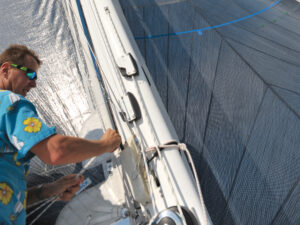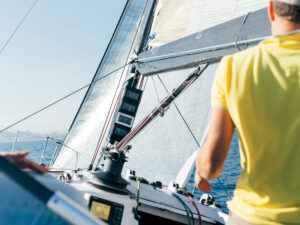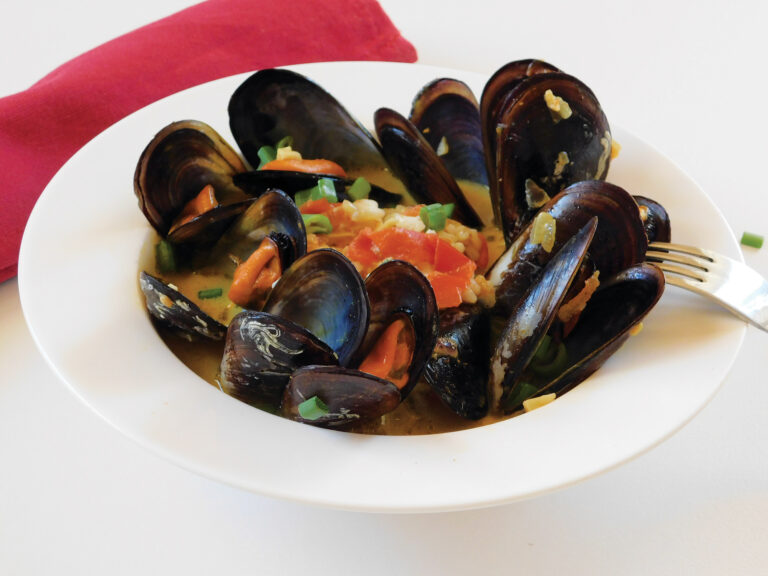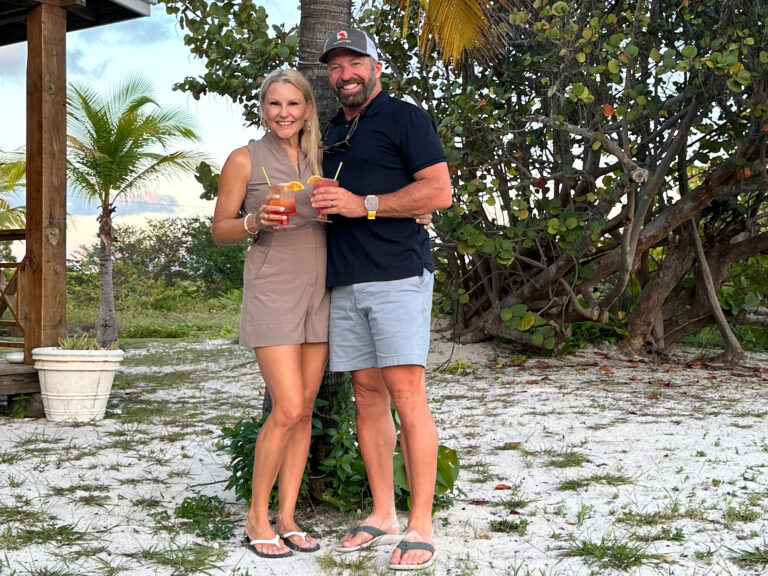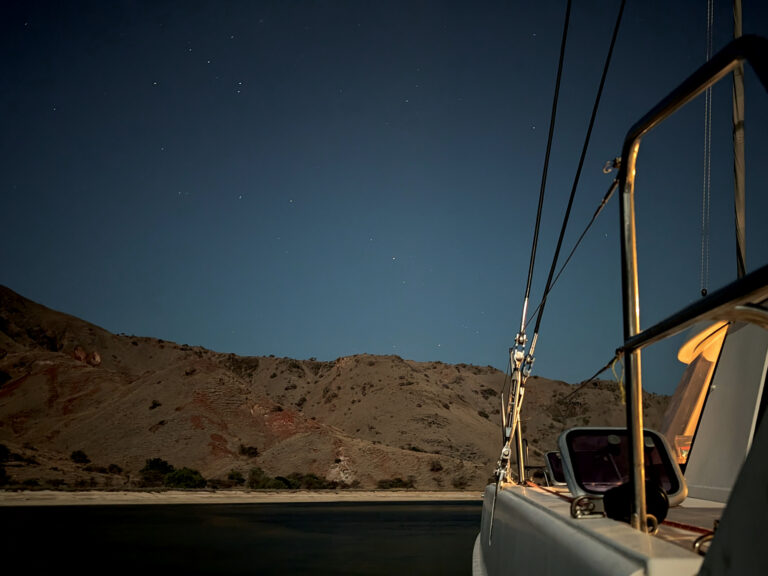
Yankee368
In November 2006, a few remaining sailors who shipped aboard the late Irving and Electa (Exy) Johnson’s 96-foot brigantine Yankee in the last century gathered at a floating dock in San Pedro, California, for a reunion of sorts.
Yankee enjoyed a distinguished career under the Johnsons, who, with young, amateur crews, completed seven circumnavigations. The 18-month voyages were educational in nature and built character in the crew through exposure to other countries and cultures.
Last fall, my wife, Jane, and I checked into our motel an hour before a reception aboard one of the two brigantines constructed for the Top Sail program in honor of Irving and Exy.
Aboard Irving Johnson, I met up with Ransom (Ranny) Duncan, a fellow member from the voyage I’d taken in 1950. The next day, we sailed aboard Exy Johnson. My former shipmate and I hauled up the mainsail’s throat halyard. About 10 other men and women put their backs into that three-strand line. From Exy, we took pictures of the Irving leaving the dock. It was cold on the Pacific, but exciting to watch the sails unfurl.
Jane sat next to Lois McCoy, a tiny, tough, kind, and smart 86-year-old, on a little bench between the mainmast pinrail and the cabin’s forward end. These were the best seats on deck, Jane said. Lois is a former cook/adventurer and has cooked her way around the world, even preparing meals for search-and-rescue teams.
We sailed out into the Pacific–Jane’s first time. Fortunately, we both wore seasick bands around our wrists. The swells pitched the ship some, and it was cold and windy. A landmass grew ahead as we reached across a west wind of 15 knots on a course almost due south, headed for the east end of…something.
“Is it mainland?” I asked a volunteer.
“No,” he said, “that’s Catalina. That dip to the west is called the Isthmus.”
Ashamed that I didn’t recognize the island, I told him that a friend and I had circumnavigated it in August.
When it was time to sail back to port, I helped furl the mainsail. With three others I stood atop the aft cabin while others loosed the lines to lower the main.
Snooping around belowdecks on Exy Johnson, we encountered James “Carl” Breed. He’d sailed with me on the Yankee cruise. The “Carl” name came about because there were four Jims aboard, and someone needed to differentiate.
Carl was 26 in 1950 when Yankee left Gloucester. Today he’s 82, the oldest of the paying crewmembers left, he claimed.
The brigantines Irving Johnson and Exy Johnson look to be pale reflections of the old steel Yankee with her hollow pipes as masts, putting diesel exhaust high in the sky, while the modern wooden ships raise varnished pine sticks, thicker than any telephone pole. The mainmast is greased to help the parrels (wooden hoops) and leather-lined gaff throat of the mainsail go up easily. The grease probably came from Sunoco, but in my day the grease would’ve come from the galley.
Robert Johnson, only surviving son of Irving and Exy, looks much like his late father, except that he has Exy’s brown eyes. He stood in bare feet on the pine deck at the wheel, wearing a light sailing shirt. He steered most of the way out and most of the way in, obviously enjoying the experience. He steered by an antique compass, the points visible but no numerals divided by 360. I asked if he was heading south. “South a quarter west,” he announced.
His wife said he’d climbed the ratlines in those bare feet. I noticed his big, thick fingers inherited from his father.
Aboard Yankee in 1950, I’d learned the salty way to make up a line after coiling it down. You reached through the center of the coil to where the line came off the pinrail, grabbed about two feet of line, twisted it, and looped it over the top of the pin. I still do it that way aboard our Columbia 30, using the top horn of a cleat.
Among our fellow passengers were sprinkled spunky geezers and widows who’d outlived spunky husbands. One, Gilly Burlingham, had a sister who had sailed on the fourth of the Johnson’s circumnavigations. She looked at my nametag and said, “Your ancestors fled France with the Huguenots.” I affirmed her charge, saying they’d settled first in northeast Maryland in the late 1700s.
The thrill of the three-hour sail was watching up close from Exy as Captain Steve Peckham brought Irving Johnson to dock under sail. “Drop staysail!” he shouted, and then, “Scandalize main!” Ever since I was a kid I knew what scandalize meant: Drop the peak of the gaff to de-power the mainsail.
At the Saturday night banquet at Cabrillo Beach Yacht Club, someone called for a show of hands among the 80 souls: “How many of you actually completed a circumnavigation on Yankee?”
Fifteen hands went up, Carl Breed’s among them, but not Ranny Duncan’s. Ranny had left the ship in Zamboanga, Philippines, because his parents had insisted he come back to finish college.
I didn’t raise my hand either because I’d lasted but five weeks. From Gloucester to Panama, I was seasick all the time except when the boat was in port.
At the table, Ranny gave an account of Irving Johnson’s last years. In his 80s and afflicted with Parkinson’s disease, Irving would have Exy drive him to the top of a hill above the Connecticut River valley near Hadley, Massachusetts, where they’d retired to his family’s farmhouse in which he’d grown up. Arms shaking, Irving would unfold his hang glider, take off into the wind, and land in his own yard.
There was a knot-naming contest at the banquet Saturday night. Robert Johnson passed out paper and asked the aging sailors who could name the 10 knots that his father said were all anyone needed to know. Ranny and I won the contest because I remembered the towboat hitch. I remember Skipper showing me how to tie it. The prize for the contest was a book about Pitcairn Island edited by Exy.
On Sunday, we met the rest of the reunion group for breakfast at a harborside Mexican restaurant, where we ran into Roger Bellinger. On Yankee’s sixth world voyage, Roger discovered Hawaii, noting its climate somewhat better than that of his native Michigan. After the cruise he moved there, married, and taught school.
He told us how he had first secured his berth on Yankee through a letter-writing campaign in 1952. Every week he wrote. He called. When Irving came to East Lansing, Michigan, to show their films, Roger pestered Irving in person. Finally, Irving told Roger the roster had filled for the sixth voyage but that some people usually drop out at the last minute. A few weeks later, Roger got word that there was room for him, but that he’d need a letter from the draft board giving him an exemption. That letter came through just a week before the sailing date.
In the end, what is the lesson to be learned from this gathering of old salts? I’d always felt an outsider because of my brief time aboard, but my fellow sailors welcomed me at this reunion. The lesson might be that sailors sail on. Ships may outlast or founder before their human counterparts, but the moment becomes magic when the crew becomes, as Saint-Exupery’s title character in The Little Prince, “changed forever” by the sailing experience.



